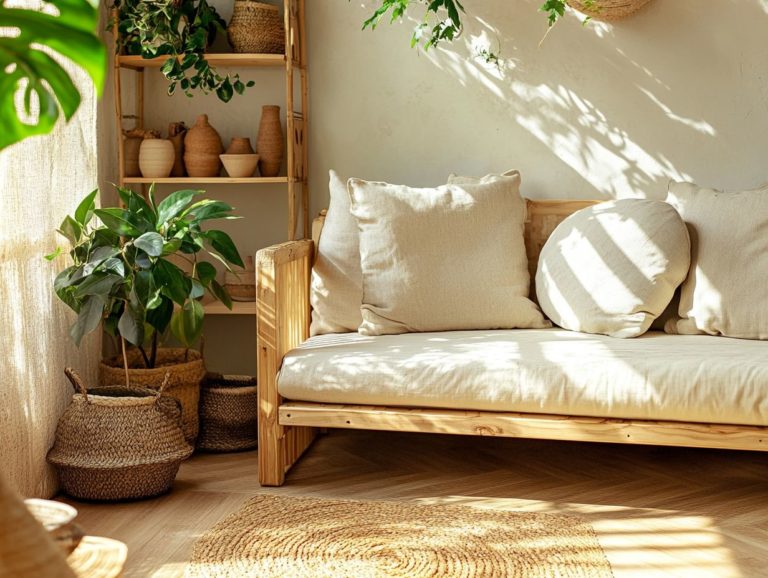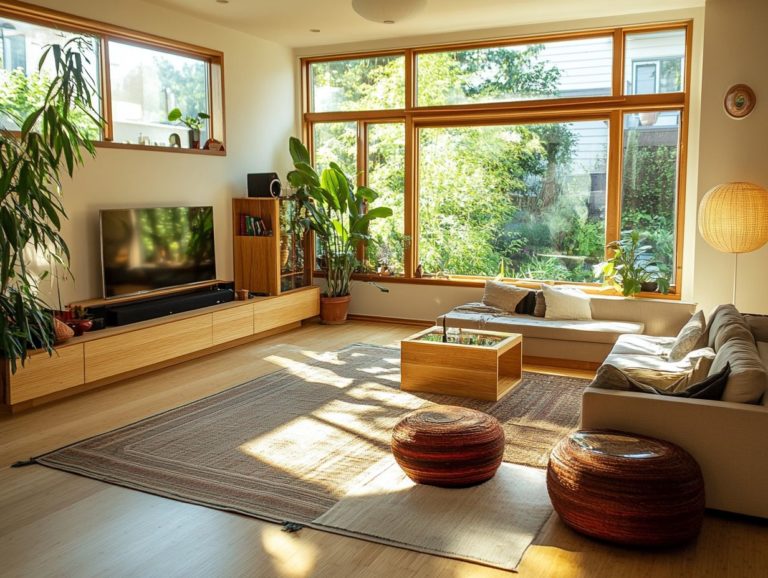5 Ways to Integrate Sustainable Materials in Decor
In a time when environmental awareness is paramount, incorporating sustainable materials into your home decor presents an opportunity that is both fulfilling and impactful. Get ready to explore five exciting ways to enhance your space!
From utilizing recycled materials to championing local artisans, each suggestion provides practical solutions that not only elevate your decor but also foster a more sustainable future. Explore these ideas to discover how you can transform your home with eco-friendly choices that beautifully align with your style and values.
Contents
- Key Takeaways:
- 1. Use Recycled Materials
- 2. Choose Sustainable Fabrics
- 3. Incorporate Natural Elements
- 4. Upcycle Old Items
- 5. Support Local Artisans
- What Is Sustainable Decor and Why Is It Important?
- How Can Sustainable Decor Benefit the Environment?
- What Are Some Examples of Sustainable Materials for Decor?
- How Can One Incorporate Sustainable Materials in Their Home?
- What Are Some Challenges of Using Sustainable Materials in Decor?
- What Are Some Tips for Maintaining Sustainable Decor in the Long Run?
- Frequently Asked Questions
- What are some ways to incorporate sustainable materials in decor?
- How can recycled materials make decor more sustainable?
- What organic and natural materials can be used in decor?
- Why is choosing second-hand or vintage items sustainable?
- How do renewable materials make decor sustainable?
- Why support local artisans using eco-friendly materials?
Key Takeaways:
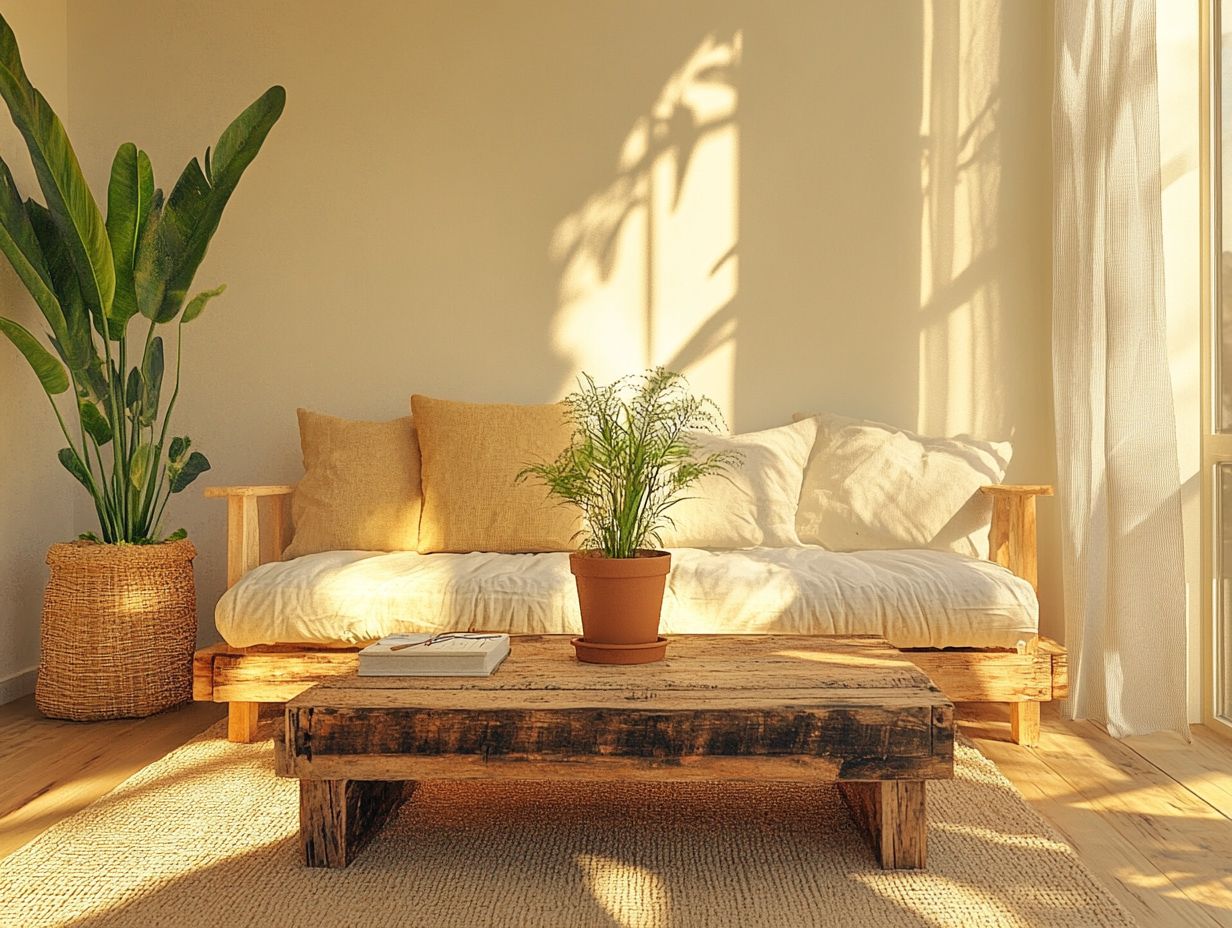
- Choose recycled or repurposed materials to cut down on waste. This helps the environment by reducing what goes to landfills.
- Select fabrics made from sustainable sources like organic cotton or bamboo to support eco-friendly production.
- Incorporate elements from nature, such as plants or wooden furniture, to add sustainability and promote a calming atmosphere.
1. Use Recycled Materials
Using recycled materials in your interior design enhances the aesthetic appeal of your space while significantly reducing your environmental impact. Additionally, incorporating sustainable materials for outdoor decor ideas aligns beautifully with sustainable practices that prioritize waste reduction.
Reclaimed wood allows you to craft unique pieces that tell a story, all while adhering to circular design principles. Whether you’re searching for furniture or decorative accents, embracing recycled materials helps you create eco-friendly decor that champions a healthier planet.
Beyond reclaimed wood, consider recycled metal in your design palette. It adds industrial flair while repurposing items that might otherwise languish in a landfill. Textiles made from recycled fibers can infuse your spaces with comfort and color, transforming them with vibrant textures while ensuring minimal resource use.
By opting for these materials, you support a circular economy that minimizes waste and reduces carbon footprints. Your choices extend beyond individual spaces; they elevate community engagement and foster awareness about sustainable living.
2. Choose Sustainable Fabrics
Choosing sustainable fabrics like organic cotton and bamboo elevates your interior design while supporting eco-friendly decor. For a more comprehensive look at suitable options, consider using sustainable materials for kid-friendly home decor. These materials minimize environmental impact and foster wellness.
These fabrics are free from harmful chemicals like VOCs, which can negatively affect air quality and health. Durable materials like hemp and linen lend themselves to a minimalist style that complements various home aesthetics.
Incorporating eco-friendly textiles is essential for creating holistic beauty in your home design. By integrating these fabrics into your decor, you embrace a healthier lifestyle while making a meaningful contribution to the planet. Additionally, consider how to incorporate upcycled materials in your home for a more sustainable approach.
3. Incorporate Natural Elements
Incorporating natural elements into your home connects you to nature and enhances both the aesthetic appeal and your well-being. Harnessing natural light and introducing indoor plants can elevate the ambiance of your space while reducing your carbon footprint.
Positioning mirrors to reflect light and choosing sheer window treatments maximizes the benefits of daylight. Adding wooden furniture and accents uplifts the beauty of your interior while improving air quality.
Integrating greenery, whether through potted plants or vertical gardens, purifies the air and contributes to your mental health. Together, these elements create a holistic living space where comfort and wellness seamlessly intertwine with nature.
4. Upcycle Old Items

Upcycling reduces waste and lets you create unique decor pieces that reflect your style. Transform discarded furniture into captivating art.
An old dresser can become a charming TV stand with a fresh coat of paint. Wooden pallets can also effortlessly evolve into rustic coffee tables.
When selecting items for upcycling, focus on sturdy materials that can handle alterations, like solid wood or metal. Choosing pieces with interesting shapes or textures can spark innovative designs and elevate your home decor.
5. Support Local Artisans
Supporting local artisans enhances your design with unique handcrafted items. It also promotes sustainable wood products and helps the local economy.
By purchasing from these talented creators, you significantly reduce your carbon footprint. Artisans typically source materials locally, minimizing transportation-related emissions.
This conscious choice fosters a deeper connection to the community. You engage directly with the artists and understand the stories behind their work.
Local artisans often use eco-friendly methods. They create pieces with reclaimed wood or organic finishes that further elevate the integrity of their creations.
What Is Sustainable Decor and Why Is It Important?
Sustainable decor focuses on design choices that prioritize environmental health. Using energy-efficient appliances and sustainable materials creates visually stunning and environmentally responsible spaces.
This approach is essential for minimizing your ecological footprint and contributing to a healthier planet. Thoughtful design enhances your well-being.
Emphasizing recycled, biodegradable, or sustainably harvested materials actively promotes a circular economy. This helps reduce waste and toxins in both construction and daily living.
Guiding principles like low-impact living and resource conservation can steer your decisions. These allow you to craft harmonious environments that deepen your connection with nature.
Certifications like LEED (Leadership in Energy and Environmental Design) recognize sustainable practices within the design community. By choosing aesthetically pleasing options aligned with preserving our natural resources, your positive impact will resonate for generations.
How Can Sustainable Decor Benefit the Environment?
Sustainable decor helps the environment by reducing waste and carbon emissions. It minimizes the ecological impact associated with conventional interior design practices.
Using eco-friendly materials like bamboo, reclaimed wood, and recycled metals creates a healthier living space. Selecting energy-efficient appliances and LED lighting helps cut down on electricity consumption.
These thoughtful choices support a holistic approach to reducing environmental harm. They promote a lifestyle that values longevity and resourcefulness.
By embracing these practices, you nurture the planet while enhancing your living environment.
What Are Some Examples of Sustainable Materials for Decor?
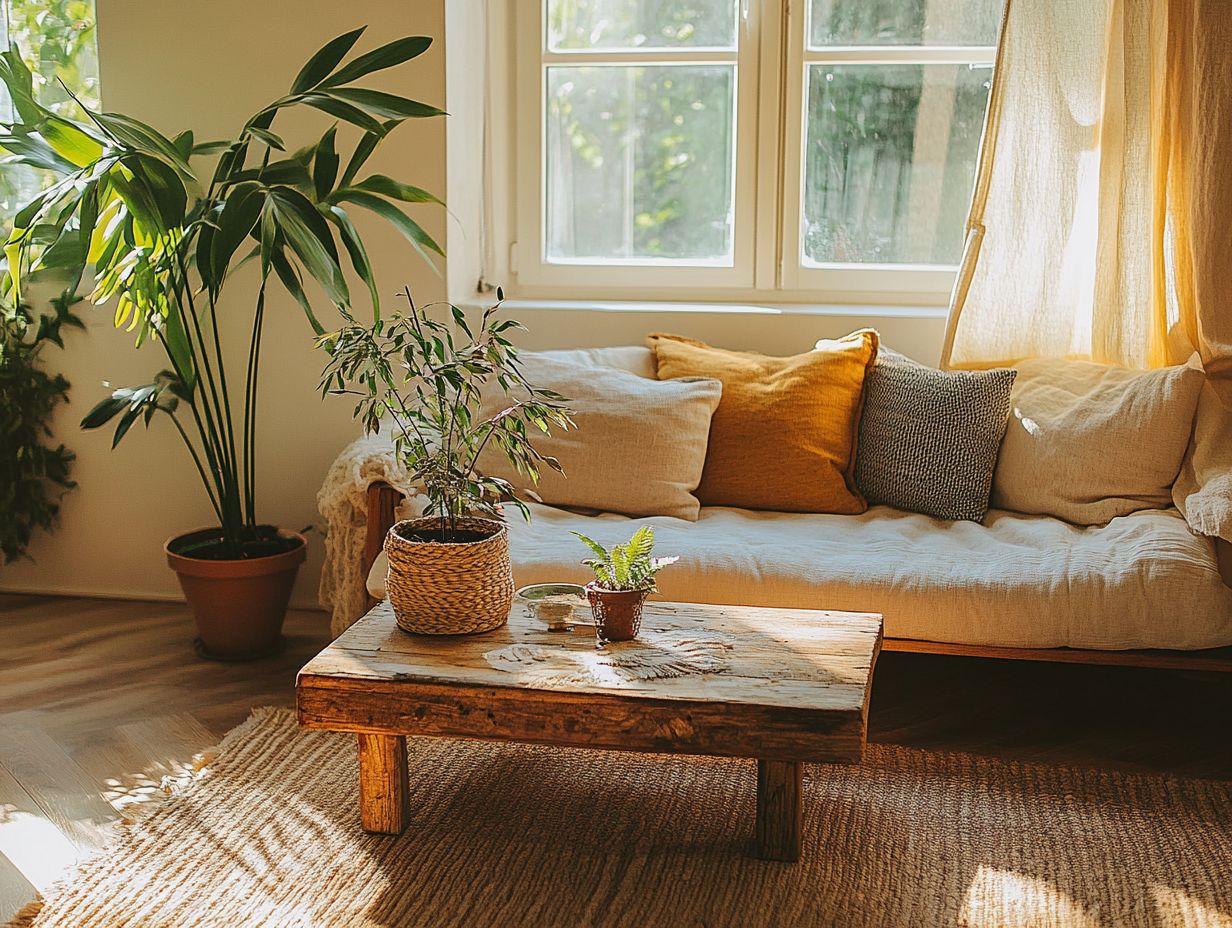
Consider incorporating sustainable materials into your decor to elevate both aesthetics and caring for the environment. Reclaimed wood for furniture offers a rustic charm. Bamboo flooring serves as an eco-friendly surface that resonates with nature. Opting for paints that do not release harmful chemicals into the air enhances your space while contributing to healthier indoor air quality.
Embracing natural textiles like organic cotton and hemp provides comfort and minimizes the environmental impact typically associated with conventional fabrics. You might find that recycled metal elements infuse a modern flair into your design, all while reducing the demand for new raw materials. Cork, harvested from the bark of cork oak trees, stands out as an innovative, renewable, and durable option.
Sourcing these materials from responsible suppliers is crucial. Look for certifications like the Forest Stewardship Council (FSC) to ensure that wood products are harvested in environmentally sound and socially beneficial ways. You can feel good knowing your choices help the planet.
How Can One Incorporate Sustainable Materials in Their Home?
Incorporating sustainable materials into your home starts with thoughtful choices in furniture, textiles, and decor, as well as understanding how to make your home more sustainable with materials, which align with eco-friendly principles like design for disassembly.
By opting for items made from reclaimed wood or recycled metals, you can significantly reduce your environmental footprint. Additionally, choosing organic cotton or linen for your upholstery and bedding minimizes chemical use and supports more sustainable agricultural practices. For more insights, check out the top 5 benefits of using sustainable materials.
As you explore decor options, consider pieces crafted from bamboo or sustainably sourced stone to help promote a healthier planet. Practicing mindful sourcing means researching suppliers who prioritize transparency and fair labor conditions. This ensures that every step of your purchasing journey contributes to a more sustainable lifestyle.
What Are Some Challenges of Using Sustainable Materials in Decor?
While embracing sustainable materials in your decor brings a wealth of benefits, you may face some challenges, such as higher costs, limited availability, and the need for specialized knowledge. Understanding the eco-conscious home: sustainable material choices can help mitigate these issues and encourage widespread adoption.
These hurdles can be disheartening, even for the most fervent advocates. But don’t worry! Viable solutions exist to facilitate this transition.
For example, choosing local suppliers can help you save on costs by minimizing transportation expenses and bolster your community. Numerous online resources are at your fingertips, providing guidance that makes the learning curve much more manageable.
By exploring cost-effective alternatives or even embarking on DIY projects, you can unleash your creativity while relishing the process. Ultimately, your perseverance in pursuing sustainable options will pave the way for broader acceptance and implementation, transforming challenges into triumphs.
What Are Some Tips for Maintaining Sustainable Decor in the Long Run?
Maintaining sustainable decor over the long haul requires a mindset focused on commitment to eco-friendly practices, ensuring that your design choices remain durable and relevant as time passes.
This means selecting materials that not only enhance your aesthetic but also endure, like reclaimed wood or organic fabrics. Regularly assessing these materials for wear and tear allows for timely maintenance, which is key to longevity.
By staying flexible with decor updates, you can create a refreshing atmosphere without the need for constant replacements.
When it’s time to enhance or replace items, making informed choices about sustainable brands can truly make a difference. This thoughtful approach elevates your space and contributes to a greater mission of environmental stewardship.
Frequently Asked Questions
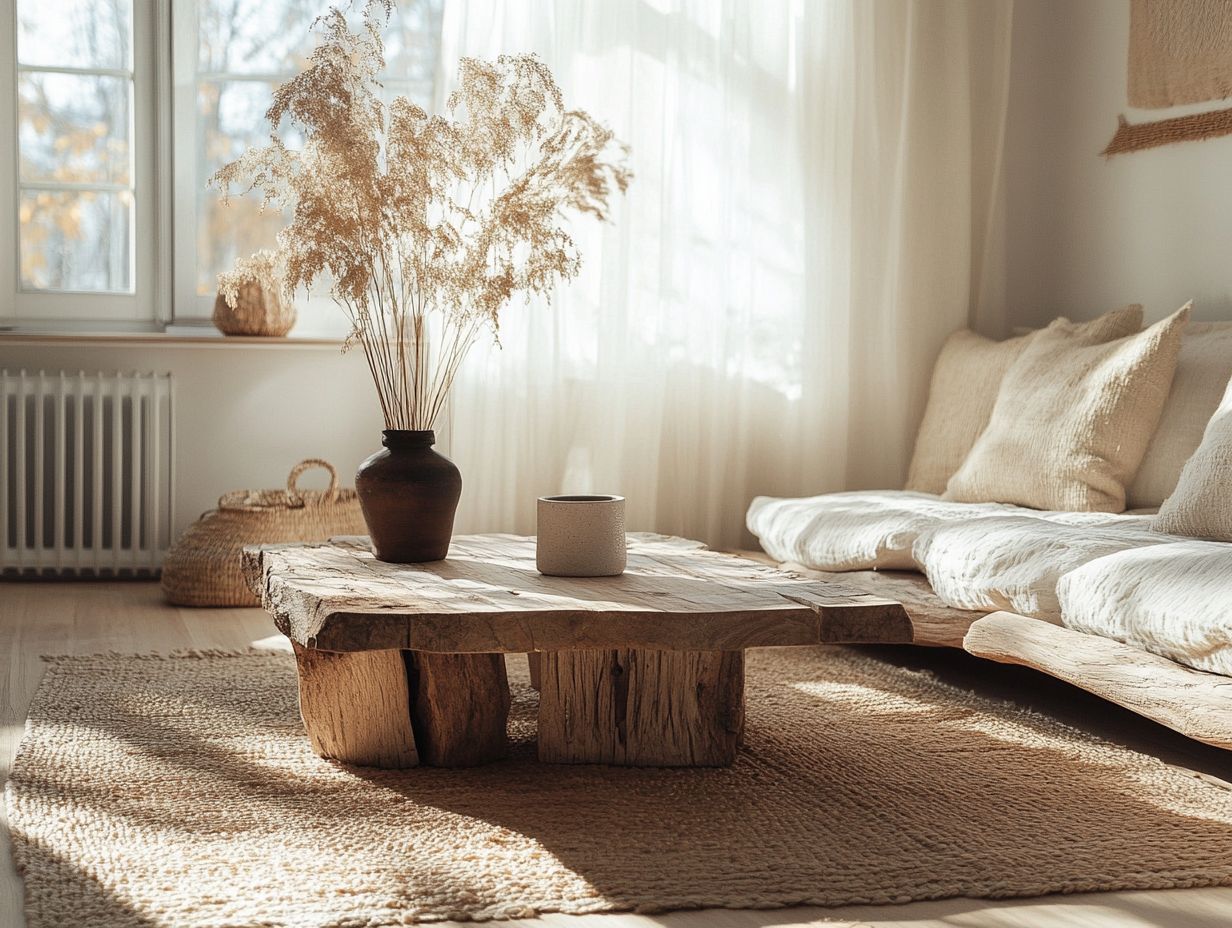
Start your sustainable decorating journey today!
What are some ways to incorporate sustainable materials in decor?
Here are a few easy ways to use sustainable materials in your decor. You can choose recycled items, natural fibers, vintage pieces, or explore maximizing style with sustainable materials in decor like renewable sources such as bamboo and cork.
How can recycled materials make decor more sustainable?
Using recycled materials cuts down on landfill waste. It also reduces the need for new resources, lowering carbon emissions.
What organic and natural materials can be used in decor?
Organic choices like cotton, wool, and bamboo are great options. They are biodegradable and made without harmful chemicals.
Why is choosing second-hand or vintage items sustainable?
Second-hand items save energy and resources by avoiding new production. They give old treasures a new life and keep them from landfills.
How do renewable materials make decor sustainable?
Materials like bamboo and cork are quickly replenished. This means they help preserve our natural resources while having a low environmental impact during production.
Why support local artisans using eco-friendly materials?
Supporting local artisans boosts the economy and encourages eco-friendly practices. Their materials are often sourced nearby, lowering carbon footprints and preserving traditional crafts.



